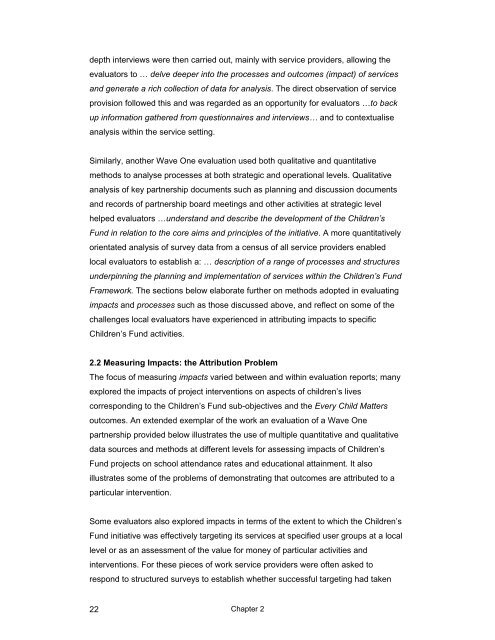Local Evaluation of Children's Services Learning from the Children's ...
Local Evaluation of Children's Services Learning from the Children's ...
Local Evaluation of Children's Services Learning from the Children's ...
- No tags were found...
Create successful ePaper yourself
Turn your PDF publications into a flip-book with our unique Google optimized e-Paper software.
depth interviews were <strong>the</strong>n carried out, mainly with service providers, allowing <strong>the</strong>evaluators to … delve deeper into <strong>the</strong> processes and outcomes (impact) <strong>of</strong> servicesand generate a rich collection <strong>of</strong> data for analysis. The direct observation <strong>of</strong> serviceprovision followed this and was regarded as an opportunity for evaluators …to backup information ga<strong>the</strong>red <strong>from</strong> questionnaires and interviews… and to contextualiseanalysis within <strong>the</strong> service setting.Similarly, ano<strong>the</strong>r Wave One evaluation used both qualitative and quantitativemethods to analyse processes at both strategic and operational levels. Qualitativeanalysis <strong>of</strong> key partnership documents such as planning and discussion documentsand records <strong>of</strong> partnership board meetings and o<strong>the</strong>r activities at strategic levelhelped evaluators …understand and describe <strong>the</strong> development <strong>of</strong> <strong>the</strong> Children’sFund in relation to <strong>the</strong> core aims and principles <strong>of</strong> <strong>the</strong> initiative. A more quantitativelyorientated analysis <strong>of</strong> survey data <strong>from</strong> a census <strong>of</strong> all service providers enabledlocal evaluators to establish a: … description <strong>of</strong> a range <strong>of</strong> processes and structuresunderpinning <strong>the</strong> planning and implementation <strong>of</strong> services within <strong>the</strong> Children’s FundFramework. The sections below elaborate fur<strong>the</strong>r on methods adopted in evaluatingimpacts and processes such as those discussed above, and reflect on some <strong>of</strong> <strong>the</strong>challenges local evaluators have experienced in attributing impacts to specificChildren’s Fund activities.2.2 Measuring Impacts: <strong>the</strong> Attribution ProblemThe focus <strong>of</strong> measuring impacts varied between and within evaluation reports; manyexplored <strong>the</strong> impacts <strong>of</strong> project interventions on aspects <strong>of</strong> children’s livescorresponding to <strong>the</strong> Children’s Fund sub-objectives and <strong>the</strong> Every Child Mattersoutcomes. An extended exemplar <strong>of</strong> <strong>the</strong> work an evaluation <strong>of</strong> a Wave Onepartnership provided below illustrates <strong>the</strong> use <strong>of</strong> multiple quantitative and qualitativedata sources and methods at different levels for assessing impacts <strong>of</strong> Children’sFund projects on school attendance rates and educational attainment. It alsoillustrates some <strong>of</strong> <strong>the</strong> problems <strong>of</strong> demonstrating that outcomes are attributed to aparticular intervention.Some evaluators also explored impacts in terms <strong>of</strong> <strong>the</strong> extent to which <strong>the</strong> Children’sFund initiative was effectively targeting its services at specified user groups at a locallevel or as an assessment <strong>of</strong> <strong>the</strong> value for money <strong>of</strong> particular activities andinterventions. For <strong>the</strong>se pieces <strong>of</strong> work service providers were <strong>of</strong>ten asked torespond to structured surveys to establish whe<strong>the</strong>r successful targeting had taken22Chapter 2
















